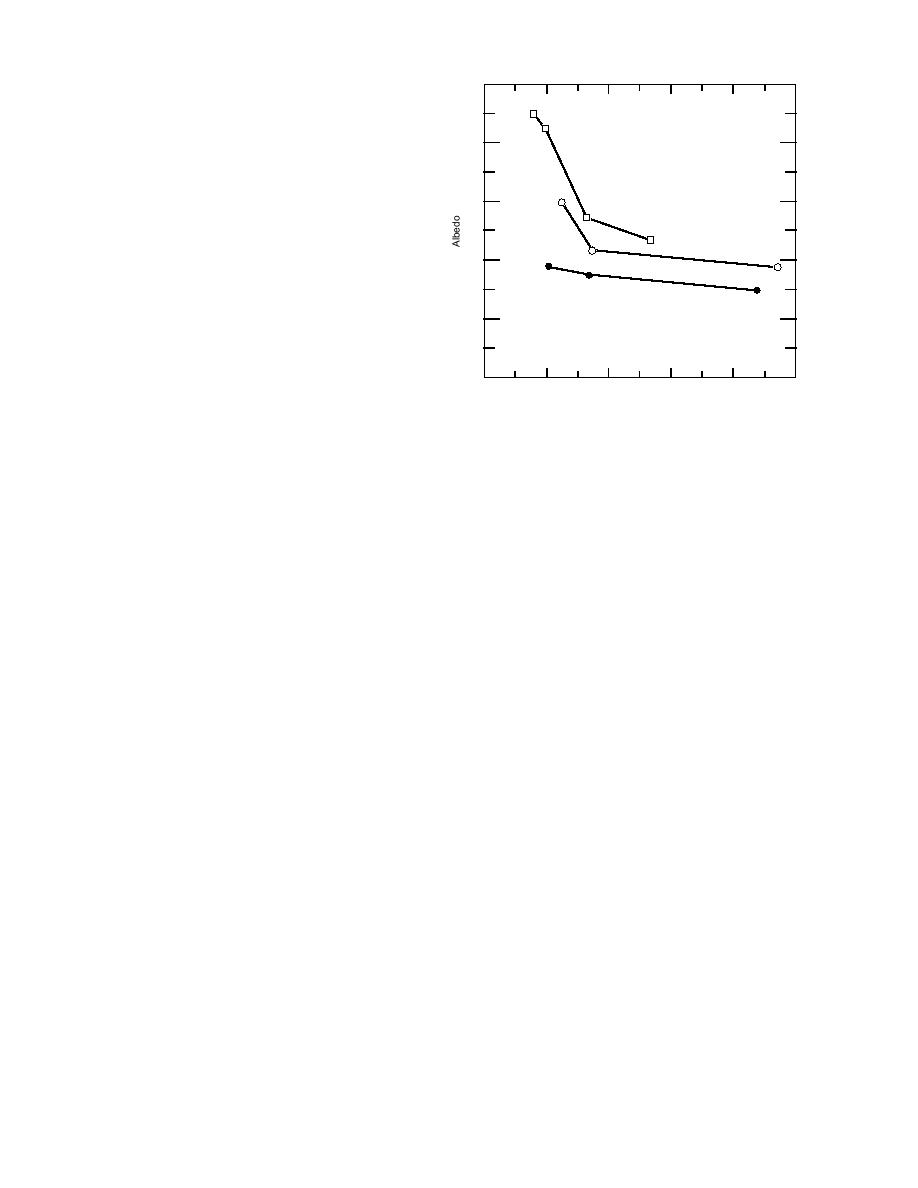
Comparing albedos in Figures 9 and 10 dem-
1.0
onstrates that, for equivalent conditions, multiyear
ice albedos are typically larger than first-year ice
values. Multiyear ice has undergone a summer
0.8
Air Temperature
melt season, with the attendant surface melting
During Growth = 37 C
and brine drainage. This results in a well-devel-
oped surface-scattering layer with many air
0.6
bubbles.
As a result of the decrease in albedo at longer
30
0.4
cloudy skies than under clear skies. The total al-
bedo depends on the spectral albedo and the spec-
10
tral incident irradiance (eq 1). Clouds absorb more
strongly in the infrared than in the visible. There-
0.2
fore on cloudy days a greater portion of the inci-
dent irradiance is at visible wavelengths, where
the albedo is larger. Total albedos under cloudy
0
5
10
15
20
25
skies are typically 812% larger than clear sky
Brine Volume (%)
values (Grenfell and Maykut 1977, Grenfell and
Figure 11. Observations of total albedo vs. brine volume
Perovich 1984). When the incident direct beam
for young ice (from Perovich and Grenfell 1981). Three
component is significant, both spectral and total
experiments were performed where the ice was grown to
albedos increase as the solar zenith angle increases
approximately 0.25 m thick and then warmed, in stages,
(sun closer to the horizon) due to enhanced specu-
to 2C.
lar reflection (Perovich and Grenfell 1982) and to
forward scattering allowing the photons to es-
cape the medium faster.
Surface conditions have a strong impact on
sions (Weeks and Hamilton 1962, Lofgren and
albedo, but the internal state and structure of the
Weeks 1969, Weeks and Ackley 1982). This leads
ice are also significant. As we have seen, the pres-
to the important conclusion that not only is the
ence of air bubbles in the upper portion of the ice
volume of brine important, but how it is distrib-
enhances albedo. Brine volume is another impor-
uted is also significant. For a given volume of
tant ice physical property that we might expect to
brine, there is more scattering if that brine is dis-
have some impact on albedo. Perovich and
tributed into many small brine inclusions, rather
Grenfell (1981) investigated the influence of brine
than a single large one. The same conclusion is
volume on albedo for young ice. Results from
true for air bubbles.
three laboratory experiments are summarized in
All of the albedos presented so far have been
Figure 11. In each experiment the ice was grown
for Arctic sea ice. Are albedos for Antarctic ice
at a selected air temperature (37, 30 and
different? Spectral albedos for young sea ice
10C), and therefore a different growth rate, to a
grown off of East Antarctica are plotted in Figure
thickness of approximately 0.25 m. Brine volume
12 (Allison et al. 1993). These albedos show the
was then varied by warming the ice. For each
same general properties as Arctic sea ice results;
experiment there is a continual decrease in al-
an increase as the ice grows thicker and a gradual
bedo as brine volume increases. As the ice warmed
wavelength dependence with larger albedos at
and the brine volume increased, individual brine
shorter wavelengths (Schlosser 1988, Allison et
pockets coalesced, forming larger but fewer in-
al. 1993). There are differences in ice structure
clusions. Thus, the result of the warming was a
between Antarctic and Arctic sea ice. Antarctic
reduction in the number of brine pockets and in
sea ice has much more frazil ice than Arctic sea
the amount of scattering. Comparing between ex-
ice and is somewhat more saline (Gow and Tucker
periments, we also see that at a given brine vol-
1990). Surface conditions also differ with signifi-
ume there is considerable variability in the ob-
cant amounts of flooded snow-covered ice but
served albedo, with faster grown ice (lower air
very little ponded ice in the Antarctic (Andreas
temperature) having larger albedos (Perovich and
and Ackley 1982). Because of this there may be
Grenfell 1981). More rapidly grown ice has smaller
differences in optical properties between Antarc-
platelet and crystal sizes and more brine inclu-
tic and Arctic sea ice, but any differences between
10



 Previous Page
Previous Page
